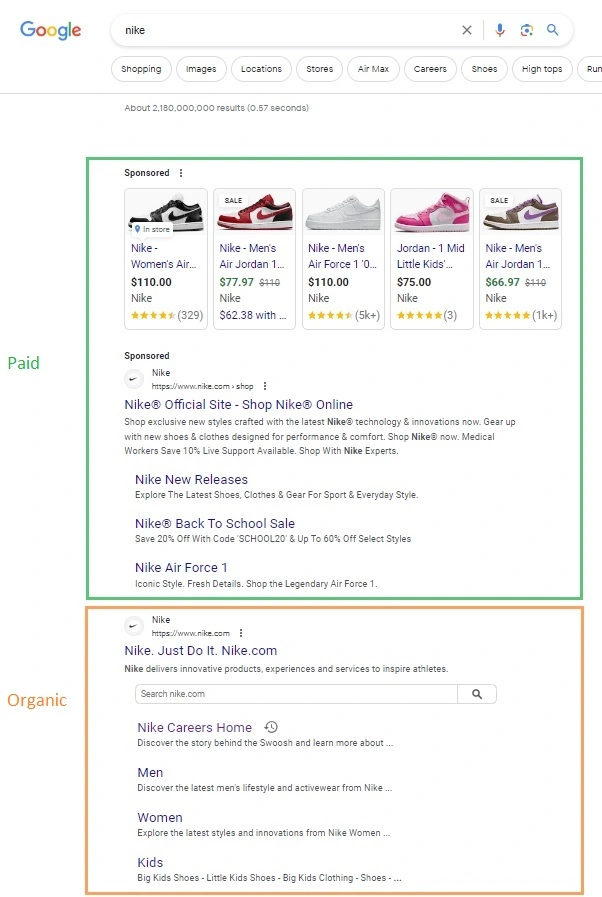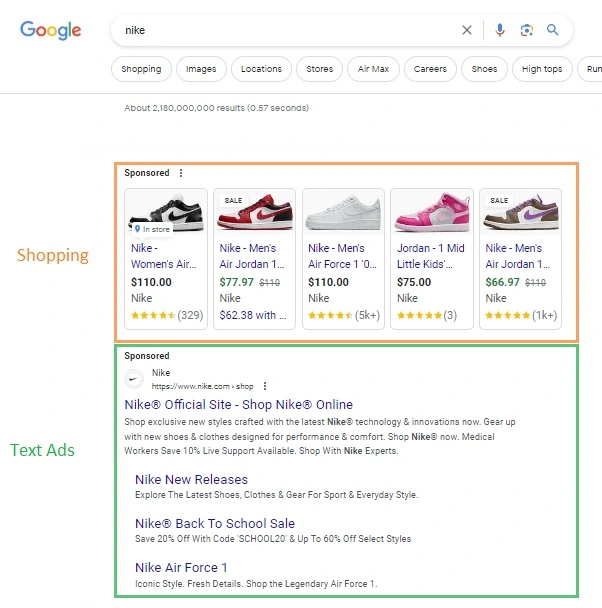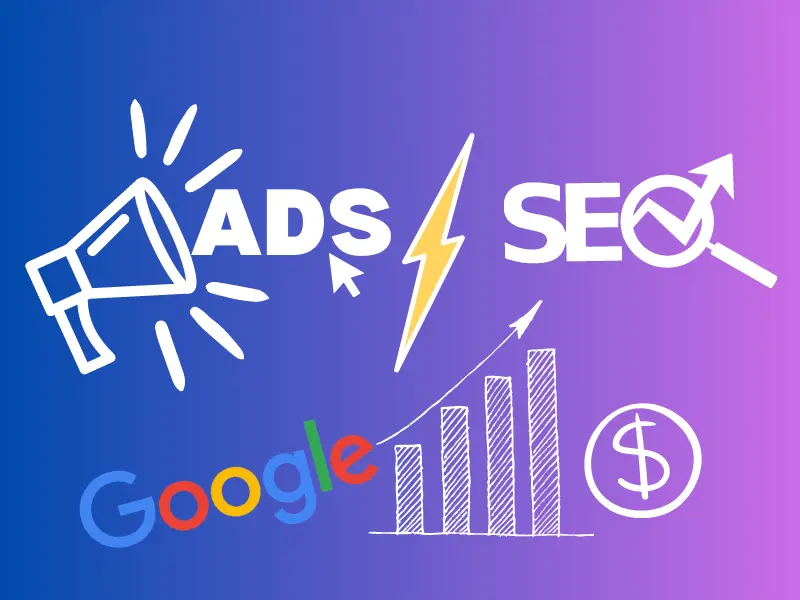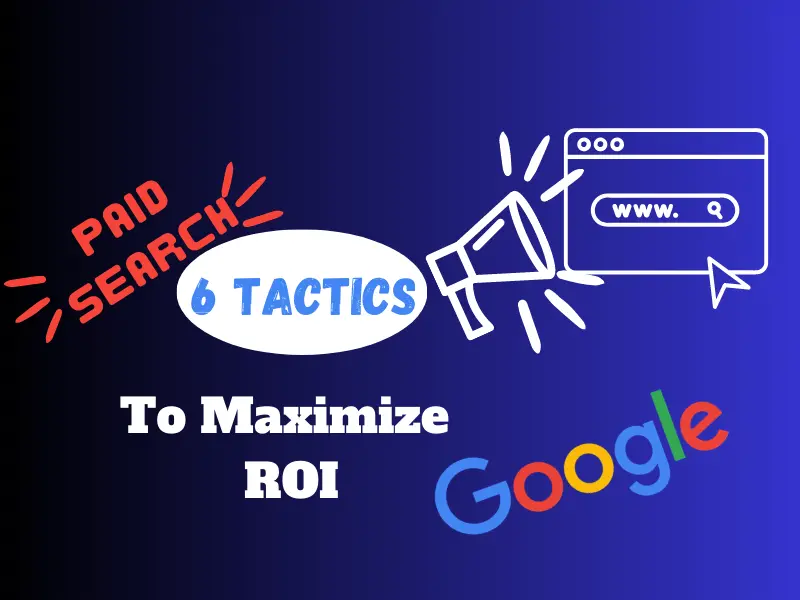SEO and Paid Search are two of the most popular digital marketing strategies. Both strategies aim to drive traffic to your website, but they do so in different ways.
When it comes to Paid Search and SEO, both have their own strengths, but combining them can lead to fantastic synergies and greater results.
In fact, combining SEO and Paid Search can help you achieve a 200% increase in conversions, according to Search Engine Watch.
Well, let’s dive into this and increase those sales! If you want to learn about a specific part of this article, click on one of the links, and you’ll be taken to that section.
What is the difference between SEO and Paid Search?
Why should you combine SEO and Paid Search?
1. Visibility on the Search Engine Results Page (SERP)
3. Divide and Conquer & Increase Efficiency
What is the difference between SEO and Paid Search?
Search Engine Optimization (SEO) is a long-term strategy that focuses on improving your website’s organic ranking in search engine results pages (SERPs).
This means optimizing your website’s content, structure, and technical elements to make it more relevant to search queries and ultimately appear at the top of search results pages.
Paid Search (or PPC)
Paid Search, also known as Pay-Per-Click (PPC), is a short-term strategy that involves bidding on keywords to have your ads appear at the top of search results pages. When someone clicks on your ad, you pay a predetermined amount.
SEO
Although SEO and paid search are different strategies, they can be used together to enhance their effects and achieve the ultimate goal of driving high-quality traffic to your website.
I should add that, despite SEO being a “free” tactic, it is getting increasingly difficult to appear on the first pages of the SERP for specific keywords. And there is a high cost associated with that as well. As with everything in digital marketing, this is another world for itself. I promise I’ll write a specific blog post about the real cost of SEO.
So why should you combine SEO and Paid Search?
SEO and PPC are highly compatible and can even enhance one another to achieve results that surpass the sum of their individual parts.
Together, they complement each other and can help to improve your bottom line, making your overall marketing program more successful.
Let’s dive into the top reasons why you should run PPC and SEO together.
1. Visibility on the Search Engine Results Page (SERP)
The combination of Paid Search and SEO enhances online exposure and improves search visibility, resulting in increased website traffic and a stronger brand presence.
Why? Having two results on the search results page for the same keyword means that your brand takes up more space on the page, which makes it more likely that a consumer will click on your organic or paid results.
This is a great tactic if you are looking to drive traffic to your website and increase brand awareness.
In the example below, you see that Nike is dominating the Results Page with its Paid (or ‘Sponsored’) result followed by its organic result.

While some companies may be tempted to discontinue their paid search marketing campaigns once they achieve strong organic rankings, it’s important to recognize that paid ads always appear higher on the search engine results page (SERP).
Thus, I recommend that you choose a set of keywords that you want to dominate in the search engine results pages (SERPs). This could include your brand name, the names of your products, or other keywords that are relevant to your business.
As a result, continuing to invest in paid search can increase visibility and improve the chances of attracting potential customers, even if your website is already proudly sitting on page 1 of the SERP through organic means.
Extensions
One important tip for paid search campaigns is to use all the available extensions to make your ad even more prominent. Here are a few examples of extensions you can add to your ads:
- Callout: Add a short message to your ad that highlights a key feature or benefit of your product or service.
- Structured snippet: Use this extension to add more information about your business to your ad, such as your hours of operation, address, or website URL.
- Sitelink: Add links to additional pages on your website to help people find what they’re looking for.
- Location: Show your business address and directions to your location in Google Maps.
2. Testing Opportunities / Keywords Research for SEO and PPC
“Keyword research” is a technique that involves using paid search to test your messaging and keyword targets before investing in SEO. Starting with SEO can be difficult due to two main challenges:
Messaging
It’s difficult to gauge whether your SEO content and Ad will resonate with your users without creating the content and Ad first. Testing messaging effectiveness can be challenging. Even if you picked the right keyword, did you create the appropriate content, Meta Deta, and Title for your audience? You won’t know until you test it.
Conversion
It’s challenging to predict whether traffic received from an SEO keyword will convert into business in the future.
Of course, you could always use tools like Ubersuggest, SEMRush, or Ahrefs to find relevant keywords to optimize your site. However, it can take a long time to build traction and drive traffic to the specific page you are testing.
- Headlines, title tags, and description copy: Are people clicking on your ad? A good metric to keep in mind is CTR (click-through rate). CTR is defined as the number of clicks divided by the number of impressions.
- Keywords and topics: Do people stay on the page where they landed and engage with the content? Is there alignment between your ad title and what they find on your website? A good metric to watch is engagement on site.
- Landing page variations: Do people convert more when you repeat the “Buy Button” twice on the page? This is part of the broader topic of A/B
- . A metric to keep an eye on is the conversion rate for each of the variations you create.
By testing your keywords through Paid Search, you can learn which keywords are profitable, which ad copy is most compelling, and if your website is set up for high conversion rates.
This information can then be used to optimize your website and improve your organic search rankings for the relevant keywords.
3. Divide and Conquer & Increase Efficiency with SEO and Paid Search
Here are three important aspects that we should cover when trying to create synergies between SEO and Paid Search.
Types of Keywords – How to Divide and Conquer
According to a Wordstream study, 64.6% of people click on Google Ads when they are looking to buy an item online.
You definitely should have sets of keywords that you want to dominate in the search engine results pages (SERPs).
This could include your brand name, the names of your products, or other keywords that are relevant to your business. However, you also need to be efficient and pay for what is worth.
One way to do this is to focus on SEO for your broad keywords that bring traffic to your website, such as “How to” or “What is” searches. These types of searches are more likely to be informational, and they can help you increase your website’s traffic and domain authority. More traffic and Domain Authority are going to help show your website more often on the first pages of the SERP.
For your more transactional keywords, such as “Buy X” or “Get X”, you can focus on Paid Search campaigns. This will allow you to target users who are already interested in buying your products or services, and it can help you to improve your conversion rates.
However, you should ensure to show that same intent, “Buy X” or “Get X” in your Ad’s title.
And let me be clear: you should not spend money on broad keywords like “red dress” with Paid Search unless you are testing it as we mentioned in the previous section.
Types of Ads
For SEO you only have one type of result, which is the typical Search Result we are used to seeing on the SERP.
However, that’s not the case for Paid Searches. You should play with different ad types to find what’s working best for you. For conversion campaigns, I suggest using these types of ads:
- Text adsThese are the most common type of ad on Google. They appear at the top and bottom of the search results page, and they are typically made up of a headline, a description, and a call to action.
- Shopping ads: These ads appear at the top of the search results page, and they show products from your online store. They include the product name, price, and image, and they can be a great way to drive traffic to your website and increase sales.

One of the things that makes Search so effective is that it allows you to include a number of extensions in your ads. These extensions can help you to make your ads more prominent in the search results and more likely to be clicked on.
Types of Bidding Strategies
Google’s SEO algorithm does take into account the intent of the person searching when ranking search results.
For example, if someone is looking for information about a specific product or service, Google will likely rank websites that are more relevant to that intent higher in the search results.
However, you can still improve your chances of ranking higher in the search results by using some sophisticated Paid Search Bidding Strategies within the Google Ads platform. Here are the most suited bid strategies that you can set on Google Ads for conversion:
- Maximize conversions: This bid strategy is for businesses that want to get as many conversions as possible from their Google Ads campaigns. Google will automatically set your bids to help you get as many conversions as possible within your budget.
- Target CPA: This bid strategy is for businesses that want to set a specific cost per acquisition (CPA). Google will automatically set your bids to help you get as many conversions as possible while staying within your target CPA.
- Target ROAS: This bid strategy is for businesses that want to set a specific return on ad spend (ROAS). Google will automatically set your bids to help you get as many conversions as possible while staying within your target ROAS.
Audiences
With SEO, you can only target people who are searching for keywords that are related to your products or services. However, with ads, you can target people based on their demographics, interests, and even past purchase history. This allows you to reach a more targeted audience and improve your chances of converting those visitors into customers.
And then there is Remarketing. I love Remarketing.
Remarketing is a type of online advertising that allows you to show ads to people who have already visited your website or interacted with your ads in some way. When someone visits your website, Google will add a small snippet of code to their browser. This code will allow you to show them ads on other websites later on.
Search remarketing allows you to show ads to people who have visited your website on Google Search. When someone searches for a keyword that is related to your business, you can show them an ad that reminds them of your website.
4. Reporting & Analytics
Through the use of cross-channel reporting, marketers can obtain a more comprehensive understanding of their digital advertising performance than ever before.
By analyzing user responses to both organic listings and PPC ads, you can gain insights into customer behavior, engagement, and conversion rates, as well as identify the most effective channels and tactics to focus on. This will help you to understand how to effectively manage your SEO and Paid Search campaigns.
Conclusion
I hope you now have an understanding of why you should use SEO and Paid Search to create synergies. The key is to develop a holistic strategy where each channel supports the keywords, audiences, goals, verticals, metrics, and initiatives it’s best suited for. This helps the channels work together to achieve complementary goals, as multiple Case Studies suggest.
Marketers can improve the landing page experience by utilizing insights from both PPC and SEO. A positive landing page user experience not only enhances quality scores but also boosts the site’s Google ranking, resulting in reduced cost per click.
Want to learn more about Paid Search? Check out this article on how to increase ROI through Paid Search.



Pingback: How to Grow your Small Business with Marketing - Digital Marketing for Growth
Pingback: How will ChatGPT affect SEO? A Few Thoughts
Pingback: Paid Search for Small Businesses: Achieve a Positive ROI
Pingback: Paid Search For Small Businesses: 6 Tactics To Maximize ROI
Pingback: What is Voice SEO? A Guide to Optimizing Your Content